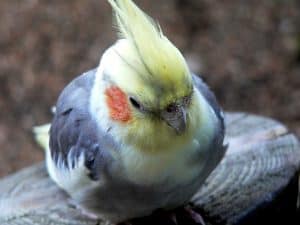Cockatiels are known for their playful and active personalities, and they are popular pets all around the world. However, it’s not uncommon for cockatiels to exhibit unusual behaviors that may indicate an underlying health issue. One such behavior is when a cockatiel sits on the bottom of its cage, which can be concerning for pet owners. Cockatiel sitting on bottom of cage may be a sign of illness, injury, or even emotional distress. As a pet owner, it’s important to be aware of the possible reasons for this behavior and take the necessary steps to ensure your cockatiel’s well-being.

Why Is My Cockatiel Sitting at the Bottom of the Cage?
The two most common reasons your cockatiel might be sitting at the bottom of the cage are because they either want to lay eggs, or they’re sick. Additionally, since older pet birds usually have arthritis, they tend to prefer staying on softer surfaces near the bottom of the cage.
A pregnant bird
Because this is the most common reason for your pet cockatiels to sit at the bottom of its cage, we’ll give them a full section of their own.
Cockatiels lay eggs whether you have one or many. It’s comparable to a month for birds, when they just lay. Because the cockatiel is a companion bird, it will produce unfertilized eggs more frequently than other birds.
Captive birds lay their eggs in a different manner than wild birds do. Even offering your cockatiel a great spot to conceal in might stimulate their reproductive cycle.
To determine if our patient has laid an egg, we need to check if she is sitting on one or if there are any eggs in her vicinity. Moving slowly and carefully is of utmost importance during these next steps.
When you reach your hand into their cage, you may not know why they are acting scared. All you can do is try to gather evidence so that way you can have a better understanding of why your cockatiel is sitting at the bottom of the cage.
If your bird has several eggs in its stomach, any vigorous movements might cause them to break while still inside of it. If the bird starts reacting aggressively, back off until it has settled down.
If the mother hen allows you, look for eggs beneath her. If she isn’t sitting on them, carefully feel her stomach to check for the shape of an egg against her skin.
If you can feel the impression of eggs, but she isn’t laying them, she could be egg-bound. Egg binding occurs when your bird is unable to naturally expel the eggs. It’s time to visit the veterinarian if your bird is straining at the bottom of the cockatiel cage and can’t remove the eggs on her own. The length of treatment will be determined by how long your pet has attempted to give birth before being unsuccessful.
Caring for the eggs

You can tell the gender of your pet bird by finding eggs at the bottom of their cage. If you bought your bird from a store, it’s possible that the person who sold it to you was honest about its gender, but mistakes happen. So if you thought you were buying a male bird but found eggs instead, that means your new bird is actually female.
By following a few key guidelines, you can take care of your pet chicken while also discouraging her from laying eggs.
The health and comfort of domesticated cockatiels will largely determine when they lay eggs, as opposed to their wild counterparts whose egg-laying is mostly determined by the environment and feeding cycle.
As you can see, several factors might cause a cockatiel to start breeding, and it may do so for the rest of its life. When your bird has finished laying her eggs, which will take up to 48 hours, don’t remove them immediately; she’ll produce more eggs as a result.
Even though these eggs are unfertilized, they still require calcium for her to lay them. It may deplete her if she continues to lay regularly.
Instead, fill a clear container with paper towels and place it on the bottom of the cage. Gently set the eggs in this container until your cockatiel loses interest in them, which should take no more than a couple of days. The significance of using a transparent container is that a darker environment may encourage her to produce even more eggs.
- Size: 15cm x 25cm/5.9'' x 9.8''. Each perch is unique and will differ in shape (not size) from the perch pictured
- Made of high quality wood and hardware, durable
- The unique shape of the perches provides excellent foot exercise
- An ideal place designed for your friends to play and climb, easy install in the cage
- Each perch is unique, none are the same and may vary between them,thickness and bending
Cockatiel Sitting on Bottom of Cage: Other symptoms to look out for and workable solutions
If they are not giving birth, it’s time to look for any other indicators that they’re displaying or potential treatments.
A cockatiel in the wild is a ground forager. How active do they appear when they’re on the bottom of the cage? Are they staring at fallen seeds or resting? Being energetic and consuming food are both good indications that they’re down there for a purpose, which is to acquire more food.
Cockatiels can live up to 30 years when kept in their natural condition, therefore they may prefer a cushier lower portion of their cage over metal bars that might harm their arthritis. Keep an eye on them while they’re down there.
Are they looking for something to do for a long period of time, or are they gnawing on seeds?
Sickness in the wild often leads to death, and cockatiels don’t have as long of a history with domestication. So, they usually try to conceal any sickness from their owners until they can’t hide it anymore.
If you are confident your bird is not pregnant, the best option is to take them to see a doctor as soon as possible. Some doctors specialize in birds and are known as Avian Veterinarians, but if that’s not an option for you then taking them to your local vet will work just fine.
Here are some other indications that your cockatiel even young birds is unwell:
- Not eating
- Fluffed up
- Unusual stool
- Vomiting
- Sneezing
In order to allow your vet to provide an accurate diagnosis and the necessary assistance, be sure to give them a full rundown of your cockatiel’s symptoms. Be a responsible cockatiel owner.




